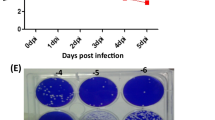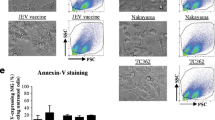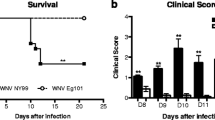Abstract
In India, Japanese encephalitis virus (JEV) remains one of the major causative agents of pediatric encephalitis. Macrophages support various neurotropic viruses and influence the immune response. However, the functional status of human macrophages during JEV infection remains unidentified. In this study, we examined the cytokine response and co-stimulatory marker levels in primary human monocyte derived macrophages (MDMs) infected with JE057434 (neurovirulent, primary clinical isolate) or SA14-14-2 (non-neurovirulent, live-attenuated vaccine) JEV strains. We also examined the differential susceptibility of these JEV strains to antiviral effects of interferon and nitric oxide. The results indicate that both JEV strains are capable of inducing various cytokines (type-I IFN, TNFα, IL6 and IL8) and co-stimulatory molecules (CD86 and CD80) in MDMs. However, they varied in replication potential and corresponding interferon sensitivity. SA14-14-2 was highly susceptible to interferon and nitric oxide when compared to JE057434. Thus, reduction in infectious virion production and increased sensitivity of SA14-14-2 towards interferon in MDMs could potentially play a role in limiting viral spread to additional target tissues.





Similar content being viewed by others
References
Erlanger ET, Weiss S, Keiser J, Utzinger J, Wiedenmayer K (2009) Past, present, and future of Japanese Encephalitis. Emerg Infect Dis 15(1):1–7
Gore MM (2004) Japanese encephalitis virus: host-Virus interactions. In: Mishra AC (ed) NIV commemorative compendium, 1st edn. NIV, Pune, pp 357–405
CDC JEV fact sheet. http://www.cdc.gov/ncidod/dvbid/jencephalitis/facts.htm
Kumar P, Krishna DV, Sulochana P, Nirmala G, Haridattatreya M, Satchidanandam V (2004) Cell-mediated immune responses in healthy children with a history of subclinical infection with Japanese encephalitis virus: analysis of CD4+ and CD8+ T cell target specificities by intracellular delivery of viral proteins using the human immunodeficiency virus Tat protein transduction domain. J Gen Virol 85:471–482
Solomon T (2004) Flavivirus encephalitis. N Engl J Med 351:370–378
Libraty HD, Nisalak A, Endy PT, Suntayakorn S, Vaughn WD, Innis LB (2002) Clinical and immunological risk factors for severe disease in Japanese encephalitis. Trans R Soc Trop Med Hyg 96:173–178
Yu YX, Zhang GM, Guo YP, Ao J, Li HM (1988) Safety of a live-attenuated Japanese encephalitis virus vaccine (SA14-14-2) for children. Am J Trop Med Hyg 39:214–217
Kumar R, Tripathi P, Rizvi A (2009) Effectiveness of one dose of SA 14–14-2 vaccine against Japanese Encephalitis. N Engl J Med 360:1465–1466
Eckels KH, Yu YX, Dubois DR, Marchette NJ, Trent DW, Johnson AJ (1988) Japanese encephalitis virus live-attenuated vaccine, Chinese strain SA 14–14-2; adaptation to primary canine kidney cell cultures and preparation of a vaccine for human use. Vaccine 6:513–518
Li Y, Yea J, Yanga X, Xua M, Chena L, Meia L, Zhua J, Liua X, Chena H, Cao S (2009) Infection of mouse bone marrow-derived dendritic cells by live attenuated Japanese encephalitis virus induces cells maturation and triggers T cells activation. Vaccine 29:855–862
Woodson ES, Freiberg NA, Holbrook RM (2011) Differential cytokine responses from primary human Kupffer cells following infection with wild-type or vaccine strain yellow fever virus. Virology 412:188–195
Aleyas GA, George AJ, Han WY, Rahman MM, Kim JS, Han BS, Kim SB, Kim K, Eo KS (2009) Functional modulation of dendritic cells and macrophages by Japanese encephalitis virus through MyD88 adaptor molecule-dependent and -independent pathways. J Immunol 183:2462–2474
Mathur A, Bharadwaj M, Kulshreshtha R, Rawat S, Jain A, Chaturvedi UC (1988) Immunopathological study of spleen during Japanese encephalitis virus infection in mice. Br J Exp Pathol 69:423–432
Kedarnath N, Gore MM, Dayaraj C, Sathe SP, Ghosh NS (1986) Effect of various mitogens on the replication of Japanese encephalitis virus in human mononuclear leukocyte cultures. Indian J Med Res 84:231–238
Ellermann-Eriksen S (2005) Macrophages and cytokines in the early defense against herpes simplex virus. Virol J 2:59. doi:10.1186/1743-422X-2-59
King NJ, Getts RD, Getts TM, Rana S, Shrestha B, Kesson MA (2007) Immunopathology of flavivirus infections. Immunol Cell Biol 85:33–42
Dejnirattisai W, Duangchinda T, Lin LC, Vasanawathana S, Jones M, Jacobs M, Malasit P, Xu NX, Screaton G, Mongkolsapaya J (2008) A complex interplay among virus, dendritic cells T cells, and cytokines in dengue virus infections. J Immunol 181:5865–5874
Spaeth BG, Longman SR, Albert LM, Rice MC (2005) Live attenuated yellow fever 17D infects human DCs and allows for presentation of endogenous and recombinant T cell epitopes. J Exp Med 202:1179–1184
Winter PM, Dung MN, Loan TH, Kneen R, Wills B, Thu TL, House D, White JN, Farrar JJ, Hart AC, Solomon T (2004) Proinflammatory cytokines and chemokines in humans with Japanese Encephalitis. J Infec Dis 190:1618–1626
Nasveld EP, Ebringer A, Elmes N, Bennett S, Yoksan S, Aaskov J, McCarthy K, Kanesathasan N, Meric C, Reid M (2010) Long term immunity to live attenuated Japanese encephalitis chimeric virus vaccine—randomized, double-blind, 5-year phase II study in healthy adults. Human Vaccines 6:1–9
Arroyo J, Guirakhoo F, Fenner S, Zhang ZX, Monath TP, Chambers TJ (2001) Molecular basis for attenuation of neurovirulence of a yellow fever Virus/Japanese encephalitis virus chimera vaccine (ChimeriVax-JE). J Virol 75:934–942
Pichyangkul S, Endy PT, Kalayanarooj S, Nisalak A, Yongvanitchit K, Green S, Rothman LA, Ennis AF, Libraty HD (2003) A blunted blood plasmacytoid dendritic cell response to an acute systemic viral infection is associated with increased disease severity. J Immunol 171:5571–5578
Aguilar PV, Paessler S, Carrara SA, Baron S, Poast J, Wang E, Moncayo CA, Anishchenko M, Watts D, Tesh BR, Weaver CS (2005) Variation in interferon sensitivity and induction among strains of eastern equine encephalitis virus. J Virol 79:11300–11310
Liang JJ, Liao LC, Liao TJ, Lee LY, Lin LY (2009) A Japanese encephalitis virus vaccine candidate strain is attenuated by decreasing its interferon antagonistic ability. Vaccine 27:2746–2754
Akaike T, Maeda H (2000) Nitric oxide and virus infection. Immunology 101:300–308
Johnson RT, Burke DS, Elwell M, Leake CJ, Nisalak A, Hoke CH, Lorsomrudee W (1985) Japanese encephalitis: immunocytochemical studies of viral antigen and inflammatory cells in fatal cases. Ann Neurol 18:567–573
Ravi V, Parida S, Desai A, Chandramuki A, Gourie-Devi M, Grau EG (1997) Correlation of tumor necrosis factor levels in the serum and cerebrospinal fluid with clinical outcome in Japanese encephalitis patients. J Med Virol 51:132–136
Ye C, Abraham S, Wu H, Shankar P, Manjunath N (2011) Silencing early viral replication in macrophages and dendritic cells effectively suppresses flavivirus encephalitis. PLoS One 6(3):e17889. doi:10.1371/journal.pone.0017889
Hase T, Dubois RD, Summers LP, Downs BM, Ussery AM (1993) Comparison of replication rates and pathogenicities between the SA 14 parent and SA 14–14-2 vaccine strains of Japanese encephalitis virus in mouse brain neurons. Arch Virol 130:131–143
Ni H, Chang JG, Xie H, Trent WD, Barrett A (1995) Molecular basis of attenuation of neurovirulence of wild-type Japanese encephalitis virus strain SA14. J Gen Virol 76:409–413
Nitayaphan S, Grant AJ, Chang JG, Trent WD (1990) Nucleotide sequence of the virulent SA- 14 strain of Japanese encephalitis virus and its attenuated vaccine derivative, SA14-14-2. Virology 177:541–552
Lee E, Lobigs M (2002) Mechanism of virulence attenuation of glycosaminoglycan-binding variants of Japanese encephalitis virus and Murray Valley encephalitis virus. J Virol 76:4901–4911
Wang T, Town T, Alexopoulou L, Anderson FJ, Fikrig E, Flavell AR (2004) Toll-like receptor 3 mediates West Nile virus entry into the brain causing lethal encephalitis. Nat Med 10:1366–1373
Wang PJ, Liu P, Latz E, Golenbock TD, Finberg WR, Libraty HD (2006) Flavivirus activation of plasmocytoid dentritic cells delinates key elements of TLR7 signaling beyond endosomal recognition. J Immunol 177:7114–7121
Cao S, Li Y, Ye J, Yang X, Chen L, Liu X, Chen H (2011) Japanese Encephalitis Virus wild strain infection suppresses dendritic cells maturation and function, and causes the expansion of regulatory T cells. Virol J 8:39
Hsu CT, Gao QJ, Lu HK, Tsai HC, Huang YC, Tzang SB (2008) Japanese encephalitis virus envelope protein mitigates TNF-alpha mRNA expression in RAW264.7 cells. Inflammation 31:133–140
Arjona A, Ledizet M, Anthony K, Bonafé N, Modis Y, Town T, Fikrig E (2007) West Nile virus envelope protein inhibits dsRNA-induced innate immune responses. J Immunol 179:8403–8409
Samuel AM, Diamond SM (2005) Alpha/beta interferon protects against lethal west nile virus infection by restricting cellular tropism and enhancing neuronal survival. J Virol 79:13350–13361
Diamond M, Roberts T, Edgil D, Lu B, Ernst J, Harris E (2000) Modulation of dengue virus infection in human cells by alpha, beta, and gamma interferons. J Virol 74:4957–4966
Macejak D, Jensen K, Pavco P, Phipps K, Heinz B, Colacino J, Blatt L (2001) Enhanced antiviral effect in cell culture of type 1 interferon and ribozymes targeting HCV RNA. J Viral Hepat 8:400–405
Lin R, Liao C, Lin E, Lin LY (2004) Blocking of the alpha interferon-induced Jak-Stat signaling pathway by Japanese encephalitis virus infection. J Virol 78:9285–9294
Vrati S, Agarwal V, Malik P, Wani SA, Saini M (1999) Molecular characterization of an Indian isolate of Japanese encephalitis virus that shows an extended lag phase during growth. J Gen Virol 80:1665–1671
Seitz C, Frensing T, Höper D, Kochs G, Reichl U (2010) High yields of influenza A virus in Madin–Darby canine kidney cells are promoted by an insufficient interferon-induced antiviral state. J Gen Virol 91:1754–1763
Ashour J, Laurent-Rolle M, Shi PY, García-Sastre A (2009) NS5 of dengue virus mediates STAT2 binding and degradation. J Virol 83:5408–5418
Lin Y, Huang LY, Ma S, Yeh C, Chiou S, Chen L, Liao C (1997) Inhibition of Japanese encephalitis virus infection by nitric oxide: antiviral effect of nitric oxide on RNA virus replication. J Virol 71:5227–5235
Pacher P, Beckman J, Liaudet L (2007) Nitric Oxide and Peroxynitrite in Health and Disease. Physiol Rev 87:315–424
Acknowledgements
We would like to acknowledge Dr. Bhagwat of Sahyadri Hospitals for providing buffy coat samples, Dr. M. Thakar (NARI) for flow cytometry, and Dr. V. P. Bondre (Encephalitis Group, NIV) for support in real-time PCR of JE virus. We would also like to thank Mr. Ohja (NIV), Ms. Sangeeta, Dr. Saha and Dr. Mitra (NCCS, Pune) for their help with western blotting. We are grateful to Dr. Adrien Six (Université Pierre et Marie Curie - Paris), Dr. Moanaro Biswas and Dr. A. Basu, NIV, for their critical comments during the preparation of the document. H.S is a senior research fellow of Council of Scientific and Industrial Research.
Author information
Authors and Affiliations
Corresponding author
Electronic supplementary material
Below is the link to the electronic supplementary material.
Rights and permissions
About this article
Cite this article
Sooryanarain, H., Sapkal, G.N. & Gore, M.M. Pathogenic and vaccine strains of Japanese encephalitis virus elicit different levels of human macrophage effector functions. Arch Virol 157, 1905–1918 (2012). https://doi.org/10.1007/s00705-012-1386-8
Received:
Accepted:
Published:
Issue Date:
DOI: https://doi.org/10.1007/s00705-012-1386-8




